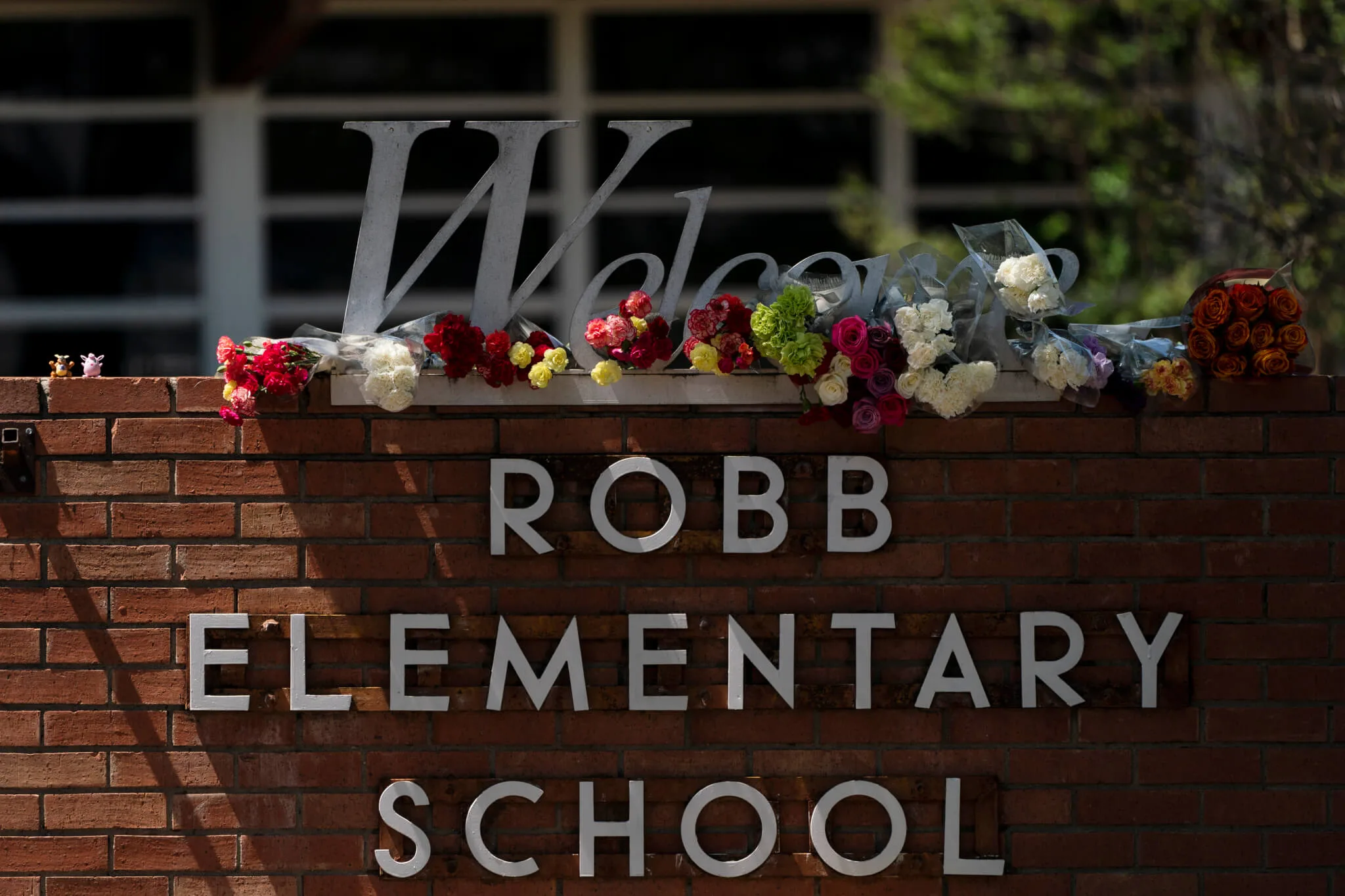
Robb Elementary School in Uvalde, Texas, on Wednesday. (AP Photo/Jae C. Hong)
Keep to your routines, limit children’s exposure to news reports, and listen to them, mental health experts say.
The murder of 19 children and two teachers in Uvalde, Texas yesterday has left parents across the country reeling, again, with anger, grief, and a sense of powerlessness. And while parents hold their children tighter today, many may feel just as overwhelmed about what to say to them, how to explain the senseless while still reassuring them that they are safe in school.
Here is some guidance from several sources on how to talk to your children about the shooting:
- Limit exposure to news reports about the shooting. “Children can overhear media and conversations that are not intended for them. It is best that they learn from a trusted adult, through meaningful and intentional conversations.”
- Ask them what they know about it and if they have any questions. ”Simply listening to the child’s feelings around their uncertainty can help them feel safe.”
- It’s ok to tell them you don’t know the answer to a question.
- Above all else, tell them you love them and always will, no matter what. “You are just what the child in your life needs and you are enough.”
The American School Counselor Association
- Routines mean stability and security, so try to keep them as normal as possible.
- Be honest and share with them as much information as they are developmentally able to handle. (See further guidance on this below.)
- If a student seems distressed, send them to the school counselor, psychologist, or social worker for support.
National Association of School Psychologists
- Reassure children that they are safe and that schools are still very safe.
- Explain that all feelings are okay when responding to tragedy like this. “Let children talk about their feelings, help put them into perspective, and assist them in expressing these feelings appropriately.”
- Be patient. “Children and youth do not always talk about their feelings readily. Watch for clues that they may want to talk, such as hovering around while you do the dishes or yard work. Some children prefer writing, playing music, or doing an art project as an outlet. Young children may need concrete activities (such as drawing, looking at picture books, or imaginative play) to help them identify and express their feelings.
- Keep your explanations developmentally appropriate.
Early elementary school children need brief, simple information that should be balanced with reassurances that their school and homes are safe and that adults are there to protect them. Give simple examples of school safety like reminding children about exterior doors being locked, child monitoring efforts on the playground, and emergency drills practiced during the school day.
Upper elementary and early middle school children will be more vocal in asking questions about whether they truly are safe and what is being done at their school. They may need assistance separating reality from fantasy. Discuss efforts of school and community leaders to provide safe schools.
Upper middle school and high school students will have strong and varying opinions about the causes of violence in schools and society. They will share concrete suggestions about how to make school safer and how to prevent tragedies in society.
Emphasize the role that students have in maintaining safe schools by following school safety guidelines (e.g. not providing building access to strangers, reporting strangers on campus, reporting threats to the school safety made by students or community members, etc.), communicating any personal safety concerns to school administrators, and accessing support for emotional needs.
Review safety procedures. This should include procedures and safeguards at school and at home. Help children identify at least one adult at school and in the community to whom they go if they feel threatened or at risk.
- Observe children’s emotional state. “Changes in behavior, appetite, and sleep patterns can also indicate a child’s level of anxiety or discomfort. In most children, these symptoms will ease with reassurance and time. However, some children may be at risk for more intense reactions. Seek the help of a mental health professional if you are at all concerned.”
- “Ensure that children get plenty of sleep, regular meals, and exercise. Encourage them to keep up with their schoolwork and extracurricular activities but don’t push them if they seem overwhelmed.”
You can click here to find the NASP’s suggested things to emphasize in your conversations with your children.
Each site also makes a big point to remind parents that to best tend to your children’s feelings, you must also tend to your own. Make sure you are processing your own grief and feelings, whatever they may be.
Was drop-off at school especially fraught this morning? We’d like to hear from you. Send us an email at [email protected].
Politics

Op-Ed: North Carolina Republicans are working overtime to restrict abortion even more. But we can stop them at the ballot box.
When I think about abortion access in North Carolina, I think about lying there on a hospital bed after I was sexually assaulted, with sympathetic...

Mark Robinson and Michele Morrow pose a threat to women and kids, warns Anderson Clayton
The state’s Democratic Party chair believes North Carolinians deserve better than a six-week abortion ban and the defunding of public schools that...
Local News

The 5 most believable UFO sightings ever reported in North Carolina
Read about five alien encounters that may forever remain unexplained. When you think of the most common places where you might hear a UFO sighting...

Good News Friday: It’s a good day to be a fan of the NC State Wolfpack
The men's and women's teams will compete for a national championship in college basketball this weekend. Plus: How to watch the solar eclipse, and...





